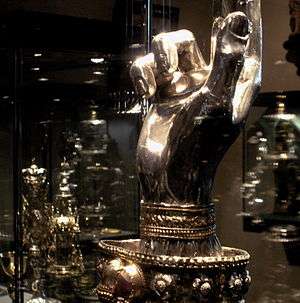Maastricht silver
Maastricht silver is a collective name for silver objects produced in Maastricht, Netherlands, mainly in the 17th and 18th centuries, when the town was a major centre for silversmithing.

History
In Maastricht, from the 16th century until the early 19th century a considerable number of silversmiths were active.[1] They were united in the guild of Saint Eligius, which via the apprentice tradition controlled the transmission of tools and techniques from generation to generation. The silver-working guild checked each piece of silver before it was stamped with three silver hallmarks: The city hallmark, a five-pointed star, indicated the quality of the silver guaranteed by the town of Maastricht. A second hallmark, the year letter, indicated the bi-annual period it was made in. The third hallmark was the mark of the silversmith.
The oldest known piece stamped with the Maastricht hallmark is the so-called arm of Saint Thomas, a 15th-century silver reliquary in the shape of an arm, now in the Treasury of the Basilica of Saint Servatius in Maastricht.[2] Unfortunately, very little is left from this period. After the Siege of Maastricht (1579) the Spanish troops ransacked the city for three days and took anything made of gold or silver.[3] Some silver chalices and monstrances from the 17th century have survived. With the arrival of the French revolutionary troops in 1794, the medieval trade system was discarded of and the guild of Saint Eligius dissolved.
Collections
The Museum aan het Vrijthof in Maastricht has the most comprehensive collection of Maastricht silver, although not nearly as complete as one would like to see. However, here one is able to discern the development of the craftsmanship throughout the various Louis styles of the 18th century. In 2012, the recently re-opened museum staged an exhibition of Maastricht silver.
The Bonnefanten Museum and the treasuries of the Basilica of Our Lady and the Basilica of Saint Servatius, all in Maastricht, as well as a number of museums, churches and private collectors in the Netherlands and around the world, own pieces of Maastricht silver.[4]
Bibliography
- Kerckhoffs, P.A.E., J. Luijt, Duurzame Glans (Exhibition Catalogue Museum aan het Vrijthof). Baarn, 2012
- Szénássy, I.L. (ed.), Maastrichts Zilver (Exhibition Catalogue Bonnefanten Museum). Maastricht, 1978
- Notes
- About 300 names of Maastricht silversmiths are known during this period (→ Szénássy, p. 8)
- In the 1970s, while being restored the reliquary was found to have five 5-pointed stars (→ Szénássy, p. 15)
- In El asalto de Mastrique por el principe Parma (1614), the Spanish playwright Lope de Vega has his characters bragging about the looting: "I was in a house full of treasures." "I was in six houses full of silver". (→ Szénássy, p. 16)
- The 1978 Bonnefanten exhibition catalogue lists 94 lenders, amongst them the Amsterdam Rijksmuseum, the Liège Curtius Museum, the Museum Claude d'Allemagne and church treasuries in Sittard, Heerlen, Liège and Huy (→ Szénássy, p. 214)
| Wikimedia Commons has media related to Maastricht silver. |
 'Pineapple cup', Petrus van Dijck (1626/27). Treasury Basilica Saint Servatius
'Pineapple cup', Petrus van Dijck (1626/27). Treasury Basilica Saint Servatius.jpg) Table bell, candle stick and other objects, Museum aan het Vrijthof
Table bell, candle stick and other objects, Museum aan het Vrijthof Jug, Joseph Balthazar Eymael (1786/1788). Museum aan het Vrijthof
Jug, Joseph Balthazar Eymael (1786/1788). Museum aan het Vrijthof_2.jpg) Silver plates (±1794). Royal Museums of Art and History, Brussels
Silver plates (±1794). Royal Museums of Art and History, Brussels-03.jpg) Maastricht silver, for sale at TEFAF in 2011
Maastricht silver, for sale at TEFAF in 2011
External links
- www.museumaanhetvrijthof.nl Website Museum aan het Vrijthof